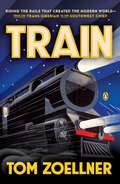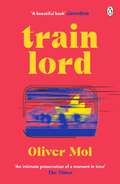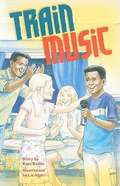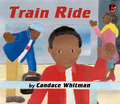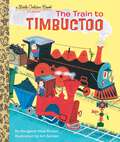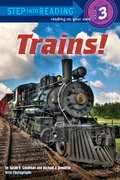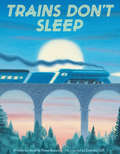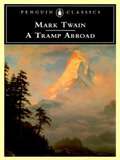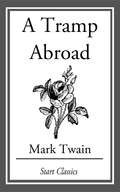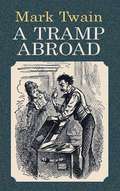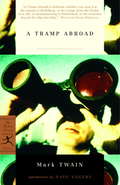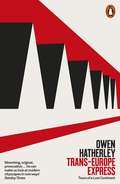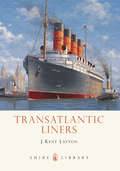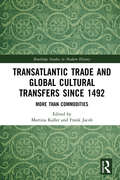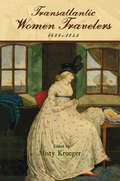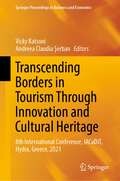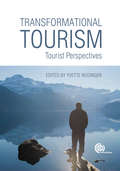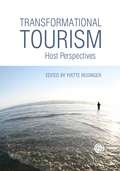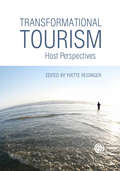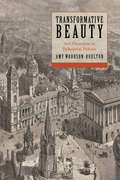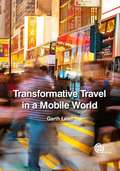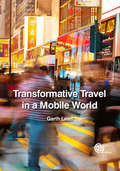- Table View
- List View
Train
by Tom ZoellnerAn epic and revelatory narrative of the most important transportation technology of the modern worldIn his wide-ranging and entertaining new book, Tom Zoellner--coauthor of the New York Times-bestselling An Ordinary Man--travels the globe to tell the story of the sociological and economic impact of the railway technology that transformed the world--and could very well change it again. From the frigid trans-Siberian railroad to the antiquated Indian Railways to the Japanese-style bullet trains, Zoellner offers a stirring story of this most indispensable form of travel. A masterful narrative history, Train also explores the sleek elegance of railroads and their hypnotizing rhythms, and explains how locomotives became living symbols of sex, death, power, and romance.ed case for the future of train travel.
Train
by Tom ZoellnerA revelatory, entertaining account of the world's most indispensable mode of transportation Tom Zoellner loves trains with a ferocious passion. In his new book he chronicles the innovation and sociological impact of the railway technology that changed the world, and could very well change it again. From the frigid trans-Siberian railroad to the antiquated Indian Railways to the futuristic MagLev trains, Zoellner offers a stirring story of man's relationship with trains. Zoellner examines both the mechanics of the rails and their engines and how they helped societies evolve. Not only do trains transport people and goods in an efficient manner, but they also reduce pollution and dependency upon oil. Zoellner also considers America's culture of ambivalence to mass transit, using the perpetually stalled line between Los Angeles and San Francisco as a case study in bureaucracy and public indifference. Train presents both an entertaining history of railway travel around the world while offering a serious and impassioned case for the future of train travel.
Train Lord: The Astonishing True Story of One Man's Journey to Getting His Life Back On Track
by Oliver MolThe astonishing true story of trust, pain, becoming lost, and finding a way back to yourself despite it all'An intimate preservation of a moment in time, full of personality' THE TIMES__________Life is beautiful - even in the dark . . .Oliver Mol was happily drifting through his twenties when the migraine exploded in his head.Suddenly, he could barely function. He felt marooned. Nothing helped. Yet he was desperate to save himself.Then he found the trains. The job of train guard has intense moments of strict, regimented activity in between periods of calm serenity. It was just what Oliver needed. Not only could he do this, but also it might be a way out.Train Lord is the story of Oliver's extraordinary recovery. A journey back into the light . . .__________'Tender, vital and quietly hopeful: a tale of remaking' Guardian'Rude, raw, visceral, painful and wildly funny' Saga 'Intense and humble, Train Lord won my heart' Australian Book Review
Train Music (Rigby PM Plus Ruby (Levels 27-28), Fountas & Pinnell Select Collections Grade 3 Level P)
by Kaye BaillieMartin would do just about anything than speak in front of people. It's his biggest fear. He is so relieved when the school bell rings and he can forget about his class speech until next semester.While travelling on a train to the city for a vacation, Martin makes a new friend. Melina is fundraising for her deaf and blind school, and has organised a singing contest on the train. Martin really likes Melina, and doesn't want to hurt her feelings, but he just can't get up there and sing in front of all those people.
Train Ride
by Candace Whitman<p>An African American boy experiences the excitement of his very first train ride with his parents. <p>Guided Reading: C ; Interest Level: Grades 1 - 1; Reading Level: Grades 1 - 1 <p>Themes: Vehicles In Motion, Families, Childhood Experiences and Memories, African/African American Interest, Beginning Concepts, People In Motion
The Train to Timbuctoo (Little Golden Book)
by Margaret Wise BrownBack in print for a new generation, a rollicking, rhyming train tale from the author of Goodnight Moon!From Kalamazoo to Timbuctoo, from Timbuctoo and back!This beloved story from 1951, about a big train and a little train that have just left Kalamazoo, has captured the imaginations of generations of children. Out of print for decades, it is back to delight little ones and their parents and grandparents again. "Clackety-clack—clackety-clack—pocketa-pocketa-pocketa"—down the track they go! Now a new generation of children will pore over the cheerful illustrations of bridges, tracks, and countryside, while listening to this rollicking tale.
Trains! (Step into Reading)
by Michael Doolittle Susan E GoodmanA Step 3 reader (Reading on Your Own) that introduces trains of all shapes and sizes doing what they do best: hauling freight, carrying passengers, and zooming at speeds close to 400 miles per hour! Readers will encounterthe Jacobite--a Scottish train that plays the Hogwarts Express in the Harry Potter films. They will learn about the great steam locomotives that crossed the United States, joining east and west in 1869. They will travel the world, visiting Japanese commuter trains so busy that men called "pushers" pack people in! And they will learn about the different technologies--steam, diesel, electric, and electromagneticthat continue to make trains such an important part of our modern world. Illustrated with full color and black & white photos.From the Trade Paperback edition.
Trains Don't Sleep
by Andria Warmflash Rosenbaum Deirdre GillPuffing, chuffing, never yawning Climbing hills as day is dawning. Trains don’t sleep, they CLANG and HOOT Cross bridges and canyons, plow through snow, charge down mountains, and meander across fields filled with sheep. And when it is time to rest and dreams are just ahead, never fear—trains don’t sleep so that you can. With the feel of a classic and vivid artwork that captures the power and majesty of trains, this is a fast-paced rhyming ode to the locomotive.
A Tramp Abroad
by Robert Gray Bruce Mark Twain Hamlin HillCast in the form of a walking tour through Germany, Switzerland, France, and Italy, A Tramp Abroad sparkles with the author's shrewd observations and highly opinionated comments on Old World culture, and showcases his unparalleled ability to integrate humorous sketches, autobiographical tidbit, and historical anecdotes in consistently entertaining narrative.
A Tramp Abroad
by Mark Twain"A Tramp Abroad" is a work of travel literature, including a mixture of autobiography and fictional events, by American author Mark Twain, published in 1880. <P> <P> The book details a journey by the author, with his friend Harris (a character created for the book, and based on his closest friend, Joseph Twichell), through central and southern Europe. While the stated goal of the journey is to walk most of the way, the men find themselves using other forms of transport as they traverse the continent. The book is the third of Mark Twain's five travel books and is often thought to be an unofficial sequel to the first one, The Innocents Abroad. As the two men make their way through Germany, the Alps, and Italy, they encounter situations made all the more humorous by their reactions to them. The narrator (Twain) plays the part of the American tourist of the time, believing that he understands all that he sees, but in reality understanding none of it.
A Tramp Abroad
by Mark Twain"A Tramp Abroad" is a work of travel literature, including a mixture of autobiography and fictional events, by American author Mark Twain, published in 1880. The book details a journey by the author, with his friend Harris (a character created for the book, and based on his closest friend, Joseph Twichell), through central and southern Europe. While the stated goal of the journey is to walk most of the way, the men find themselves using other forms of transport as they traverse the continent. The book is the third of Mark Twain's five travel books and is often thought to be an unofficial sequel to the first one, The Innocents Abroad. As the two men make their way through Germany, the Alps, and Italy, they encounter situations made all the more humorous by their reactions to them. The narrator (Twain) plays the part of the American tourist of the time, believing that he understands all that he sees, but in reality understanding none of it.
A Tramp Abroad (World Classics Ser.)
by Mark TwainThe success of Twain's first collection of travel memoirs, The Innocents Abroad, inspired a return to Europe for another look at some of the countries and landmarks that initially dazzled the author and his companions. In A Tramp Abroad, Twain's abundant humor waxes as freely as ever; this time, however, his amusement bears a more cynical cast, as he regards the grand tourist sights in Innocents through older and more experienced eyes. The seriousness of the author's second impressions provides an interesting subtext to the overall jocularity of his narrative, making this volume a milestone in the Twain oeuvre and a must for his legions of admirers. Appendix.
A Tramp Abroad
by Mark TwainThis book an EXACT reproduction of the original book published before 1923. This IS NOT an OCR'd book with strange characters, introduced typographical errors, and jumbled words. This book may have occasional imperfections such as missing or blurred pages, poor pictures, errant marks, etc. that were either part of the original artifact, or were introduced by the scanning process. We believe this work is culturally important, and despite the imperfections, have elected to bring it back into print as part of our continuing commitment to the preservation of printed works worldwide. We appreciate your understanding of the imperfections in the preservation process, and hope you enjoy this valuable book.
A Trance After Breakfast: And Other Passages
by Alan CheuseA collection of lyrical travel writings from celebrated writer and NPR commentator Alan Cheuse.
Trans-Europe Express: Tours of a Lost Continent
by Owen Hatherley'A scathing, lively and timely look at the "European city", from one of our most provocative voices on culture and architecture today' Owen JonesA searching, timely account of the condition of contemporary Europe, told through the landscapes of its citiesOver the past twenty years European cities have become the envy of the world: a Kraftwerk Utopia of historic centres, supermodernist concert halls, imaginative public spaces and futuristic egalitarian housing estates which, interconnected by high-speed trains traversing open borders, have a combination of order and pleasure which is exceptionally unusual elsewhere.In Trans-Europe Express, Owen Hatherley sets out to explore the European city across the entire continent, to see what exactly makes it so different to the Anglo-Saxon norm - the unplanned, car-centred, developer-oriented spaces common to the US, Ireland, UK and Australia. Attempting to define the European city, Hatherley finds a continent divided both within the EU and outside it. 'The latest heir to Ruskin.' - Boyd Tonkin, Independent 'Hatherley is the most informed, opinionated and acerbic guide you could wish for.' - Hugh Pearman, Sunday Times 'Can one talk yet of vintage Hatherley? Yes, one can. Here are all the properties that have made him one of the most distinctive writers in England - not just 'architectural writers', but writers full stop: acuity, contrariness, observational rigour, frankness and beautifully wrought prose.' - Jonathan Meades
Transatlantic Liners
by J. LaytonPrior to air travel there was only one way to cross the Atlantic: by ship. By the late nineteenth century, steam ships dominated the transatlantic passenger trade, growing exponentially in size as maritime technology improved and as more immigrants poured from Europe into the New World. As the liners got bigger, the scope for luxury increased, so that a substantial part of ships such as Titanic would be given over to sumptuous dining saloons, lounges, smoking rooms and even gymnasia for the most affluent passengers. Meanwhile, the bulk of passengers, the poor migrants with one-way tickets to America, were efficiently arranged in small cabins with bunks in the bows and stern of the ship. This book is an introduction to the age of the superliner, from 1900 to the modern day, exploring changes in the liner's design and role over a century that saw competition between shipping lines and between nations. The author describes the history and design of such great ships as Lusitania, Olympic, Imperator, Normandie, both queen Elizabeths, both queen Marys and, of course, the legendary Titanic. He tells the story of the heyday of the great liners before immigration to America was curtailed, the many races for the Blue Riband speed record, the experiences of rich and poor passengers, the role of the liners as troopships and hospital ships during the world wars, and the decline in the Atlantic trade after the 1960s, since when most passengers have travelled by air.
Transatlantic Trade and Global Cultural Transfers Since 1492: More than Commodities (Routledge Studies in Modern History)
by Martina Kaller Frank JacobAccess to new plants and consumer goods such as sugar, tobacco, and chocolate from the beginning of the sixteenth century onwards would massively change the way people lived, especially in how and what they consumed. While global markets were consequently formed and provided access to these new commodities that increasingly became important in the ‘Old World’, especially with regard to the establishment early modern consumer societies. This book brings together specialists from a range of historical fields to analyse the establishment of these commodity chains from the Americas to Europe as well as their cultural implications.
Transatlantic Women Travelers, 1688-1843 (Transits: Literature, Thought & Culture 1650-1850)
by Misty Krueger Diana Epelbaum Shelby Johnson Grace Gomashie Pam Perkins Ula Lukszo Klein Jennifer Golightly Alexis McQuigge Octavia Cox Victoria Barnett-Woods Kathleen Morrissey Eve Tavor BannetThis important new collection explores representations of late seventeenth- through mid-nineteenth-century transatlantic women travelers across a range of historical and literary works. While at one time transatlantic studies concentrated predominantly on men’s travels, this volume highlights the resilience of women who ventured voluntarily and by force across the Atlantic—some seeking mobility, adventure, knowledge, wealth, and freedom, and others surviving subjugation, capture, and enslavement. The essays gathered here concern themselves with the fictional and the historical, national and geographic location, racial and ethnic identities, and the configuration of the transatlantic world in increasingly taught texts such as The Female American and The Woman of Colour, as well as less familiar material such as Merian’s writing on the insects of Surinam and Falconbridge’s travels to Sierra Leone. Intersectional in its approach, and with an afterword by Eve Tavor Bannet, this essential collection will prove indispensable as it provides fresh new perspectives on transatlantic texts and women’s travel therein across the long eighteenth century.
Transcending Borders in Tourism Through Innovation and Cultural Heritage: 8th International Conference, IACuDiT, Hydra, Greece, 2021 (Springer Proceedings in Business and Economics)
by Vicky Katsoni Andreea Claudia ŞerbanThis book features the proceedings of the 8th International Conference of the International Association of Cultural and Digital Tourism (IACuDiT). Held on the Hydra Island in Greece in September 2021, the conference's lead theme was “Transcending Borders in Tourism through Innovation and Cultural Heritage”.Highlighting the contributions made by numerous writers to the advancement of tourism research, this book presents a critical academic discourse evolving tourism products and services. It also deals with strategies that help stimulate economic innovation and growth, and promote knowledge transfer. Selected chapters also deal with innovation, creativity, and change management in all aspects of tourism, culture, and heritage. A crucial focus is also placed on embracing ICT as a powerful development tool along with strategies and campaigns for smart tourism. It offers numerous examples from the whole spectrum of cultural and heritage tourism, including art, innovations in museum interpretation and collections management, cross-cultural visions, gastronomy, film tourism, dark tourism, sports tourism, and wine tourism.
Transformational Tourism
by Simone Grabowski Patrick Holladay Paul Heintzman Jennifer Erderly Annette Pritchard Stephen Wearing Dr Mark Kanning Lorraine Brown Kylie Radel Eric Brymer Nigel Morgan Yvette Reisinger Lauren Ponder Adrian Deville Ulrike Gretzel Agnes Nowaczek Yoon Jong Lee Omar Moufakkir Ian Kelly Melanie SmithTransformational Tourism deals with the important issue of how travel and tourism can change human behaviour and have a positive impact on the world. The book focuses on human development in a world dominated by post-9/11 security and political challenges, economic and financial collapses, and environmental threats. It identifies various types of tourism that can transform human beings, such as educational, volunteer, survival, community-based, eco, farm, extreme, religious, spiritual, wellness, and mission tourism.
Transformational Tourism
by Keith Keith Isaac Isaac Greg Ashworth Melanie Smith Dr Mark Kanning Omar Moufakkir Bianca Bianca Ignacio Ignacio Adrian Deville Eric Brymer Yvette Reisinger Stephen Wearing Sagar Sagar Michael Michael Anya DiekmannTransformational Tourism deals with the important issue of how travel and tourism can change human behaviour and have a positive impact on the world. The book focuses on human development in a world dominated by post-9/11 security and political challenges, economic and financial collapses, as well as environmental threats; it identifies various types of tourism that can transform human beings, such as educational, volunteer, survival, community-based, eco, farm, extreme, religious, spiritual, wellness, and mission tourism.
Transformational Tourism: Host Perspectives
by Yvette ReisingerTransformational Tourism deals with the important issue of how travel and tourism can change human behaviour and have a positive impact on the world. The book focuses on human development in a world dominated by post-9/11 security and political challenges, economic and financial collapses, as well as environmental threats; it identifies various types of tourism that can transform human beings, such as educational, volunteer, survival, community-based, eco, farm, extreme, religious, spiritual, wellness, and mission tourism.
Transformative Beauty: Art Museums in Industrial Britain
by Amy Woodson-BoultonWhy did British industrial cities build art museums? By exploring the histories of the municipal art museums in Birmingham, Liverpool, and Manchester, Transformative Beauty examines the underlying logic of the Victorian art museum movement. These museums attempted to create a space free from the moral and physical ugliness of industrial capitalism. Deeply engaged with the social criticism of John Ruskin, reformers created a new, prominent urban institution, a domesticated public space that not only aimed to provide refuge from the corrosive effects of industrial society but also provided a remarkably unified secular alternative to traditional religion. Woodson-Boulton raises provocative questions about the meaning and use of art in relation to artistic practice, urban development, social justice, education, and class. In today's context of global austerity and shrinking government support of public cultural institutions, this book is a timely consideration of arts policy and purposes in modern society.
Transformative Travel in a Mobile World
by Garth LeanThis book presents the re-theorisation of travel and transformation. It explores the factors that influence the behaviours of a traveller, how these become entwined in experiences and how travel experiences continue on a traveller's return. It uses the notion of transformation to redevelop the temporal and spatial boundaries of physical travel, develop a model for unpacking transformation and to look at new methods in the exploration of travel research.
Transformative Travel in a Mobile World
by Garth LeanThis book presents the re-theorisation of travel and transformation. It explores the factors that influence the behaviours of a traveller, how these become entwined in experiences and how travel experiences continue on a traveller’s return. It uses the notion of transformation to redevelop the temporal and spatial boundaries of physical travel, develop a model for unpacking transformation and to look at new methods in the exploration of travel research.
